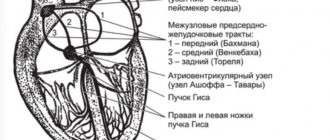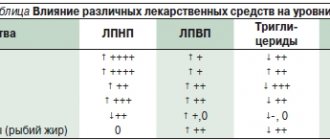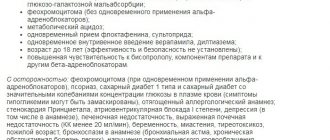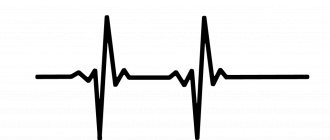I very often come across low-quality resources on the Internet; absolutely everything can be lame in them: the competence of information, presentation, lack of structure or clear examples.
That is why I decided to collect and structure all the information from such resources. And the topic of the article today will be instructions for the use of our long-suffering Panangin, it comes in two types: in film-coated tablets and in ampoules for intravenous administration. In other words, you will read about this more than once. There will also be some information not related to the effect of the drug itself, for example: owners, manufacturers, representatives, etc., this is necessary for the completeness of the picture, so I decided to leave it for you all to see. You will also find links to sources at the end of the article, enjoy reading.
pharmachologic effect
A drug that affects metabolic processes. Source of potassium and magnesium ions.
Potassium and magnesium are intracellular cations that play a major role in the functioning of many enzymes, the interaction of macromolecules and intracellular structures, and in the mechanism of muscle contractility. The intra- and extracellular ratio of potassium, magnesium, calcium and sodium ions affects myocardial contractility. A low level of potassium and/or magnesium ions in the internal environment can have a proarrhythmogenic effect, predisposing to the development of arterial hypertension, atherosclerosis of the coronary arteries and the occurrence of metabolic changes in the myocardium.
One of the most important physiological functions of potassium is maintaining the membrane potential of neurons, myocytes and other excitable structures of myocardial tissue. An imbalance between the intra- and extracellular potassium content leads to a decrease in myocardial contractility, the occurrence of arrhythmia, tachycardia and increased toxicity of cardiac glycosides.
Magnesium is a cofactor in more than 300 enzymatic reactions in energy metabolism and the synthesis of proteins and nucleic acids. Magnesium reduces contractile tension and heart rate, leading to a decrease in myocardial oxygen demand. Magnesium has an anti-ischemic effect on myocardial tissue. Decreased contractility of smooth muscle myocytes in the walls of arterioles, incl. coronary, leads to vasodilation and increased coronary blood flow.
The combination of potassium and magnesium ions in one preparation is justified by the fact that potassium deficiency in the body is often accompanied by magnesium deficiency and requires simultaneous correction of the content of both ions in the body. With simultaneous correction of the levels of these electrolytes, an additive effect is observed, in addition, potassium and magnesium reduce the toxicity of cardiac glycosides without affecting their positive inotropic effect.
Can it be used during pregnancy?
Many pregnant patients use panangin as potassium and magnesium supplements, like regular vitamins, without thinking about the possible consequences. These drugs are able to normalize the concentration of these substances, while normalizing high blood pressure. However, it should be borne in mind that the drug simultaneously reduces this indicator in hypotensive patients, which can cause serious health problems.
Unlike natural medicines, Panangin is an artificially synthesized substance, so there is no guarantee that it will not harm the fetus. No such data have been reported, but the effect of the active ingredients on the child has not been thoroughly studied. It is recommended to refrain from using the drug in the first trimester of pregnancy in order to eliminate unnecessary risks, giving preference to natural remedies, and remembering to regularly visit your doctor.
Only a specialist doctor has the right to make a decision on prescribing medications, taking into account the type of pregnancy, its duration, individual characteristics of the body, examination results and other circumstances.
Typically, pregnant women are prescribed up to two tablets per day, taken after meals. In this case, you should limit the use of vitamin complexes containing the above ingredients.
Pharmacokinetics
Suction -
When taken orally, absorption of the drug is high.
Removal -
excreted in urine.
Magnesium in food
Magnesium
. The total supply of magnesium in the body of a person weighing 70 kg is on average 24 g (1000 mmol); more than 60% of magnesium comes from bone tissue and about 40% from skeletal muscle and other tissues. About 1% of the total magnesium reserve in the body is found in extracellular fluid, mainly in blood plasma. In healthy adults, plasma magnesium levels range from 0.7 to 1.10 mmol/L.
The recommended dietary intake of magnesium for men is 350 mg/day, for women - 280 mg/day. The need for magnesium increases during pregnancy and breastfeeding.
Magnesium is absorbed into the gastrointestinal tract by active transport. The main regulator of magnesium balance in the body is the kidneys. 3–5% of ionized magnesium is excreted by the kidneys.
An increase in urine volume (for example, during therapy with highly effective loop diuretics) leads to an increase in the excretion of ionized magnesium. If absorption of magnesium in the small intestine is reduced, further hypomagnesemia leads to decreased excretion (<0.5 mmol/day).
Products containing potassium
Potassium
. The total potassium reserve in the body of a person weighing 70 kg is on average 140 g (3570 mmol). Its amount is slightly less in women than in men, and decreases slightly with age. 2% of the total potassium reserve in the body is located outside the cells, and the remaining 98% is inside the cells.
The optimal dietary intake of potassium is 3–4 g (75–100 mmol) per day. The main route of potassium excretion is renal (about 90% of potassium is excreted by the kidneys per day). The remaining 10% is excreted through the gastrointestinal tract. Thus, the kidneys are responsible for long-term potassium homeostasis as well as plasma potassium levels. In the short term, blood potassium levels are also regulated by the exchange of potassium between the intracellular and extracellular spaces.
Data on the pharmacokinetics of the drug in the form of a solution for intravenous administration are not provided.
Composition of Panangin
The tablets contain active substances: magnesium aspartate (280 mg) and potassium aspartate (316 mg).
Additional substances: silicon dioxide, corn and potato starch, talc, povidone, magnesium stearate. The shell consists of talc, macrogol 6000, titanium dioxide, methacrylic acid copolymer. The concentrate for Panangin IV solution includes magnesium aspartate (40 mg) and potassium aspartate (45.2 mg), as well as water for injection.
Dosage regimen
For oral administration
Prescribe 1-2 tablets. 3 times/day. The maximum daily dose is 3 tablets. 3 times/day.
The drug should be used after meals, because the acidic environment of the stomach contents reduces its effectiveness.
The duration of therapy and the need for repeated courses are determined by the doctor individually.
For intravenous administration
The drug is prescribed intravenously as a slow infusion. A single dose is 1-2 ampoules; if necessary, repeated administration is possible after 4-6 hours.
To prepare a solution for intravenous infusion, the contents of 1-2 amps. dissolve in 50-100 ml of 5% glucose solution.
Instructions for use of Panangin (Method and dosage)
Panangin tablets, instructions for use
How to take the medicine? The drug is taken orally three times a day, 2 tablets. Maintenance and preventive therapy: 1 tablet three times a day, course for 3-4 weeks. In some situations, a repetition of the course of therapy is required.
Instructions for intravenous use
Panangin solution is injected intravenously, slowly. The drug is administered at a rate of 20-30 drops per minute, 1-2 times a day, 300 ml. Dosing of the drug Panangin during pregnancy is carried out according to the standard regimen of medication use.
Children can take the medicine from birth.
How to take Panangin for prevention?
If you ask the question of the benefits and harms of Panangin, you should realize that this is a drug that has its own side effects, so you should not use it for prevention. Firstly, in this way you accustom the body to a high content of magnesium and potassium, and secondly, you can provoke an overabundance of these substances, which in turn can cause a lot of negative reactions.
Side effect
When taken orally
From the central nervous system and peripheral nervous system:
possible paresthesia (caused by hyperkalemia); hyporeflexia, convulsions (caused by hypermagnesemia).
From the cardiovascular system:
possible AV blockade, paradoxical reaction (increased number of extrasystoles), decreased blood pressure; redness of the facial skin (due to hypermagnesemia).
From the digestive system:
Possible nausea, vomiting, diarrhea (including those caused by hyperkalemia), a feeling of discomfort or burning in the pancreas (in patients with anacid gastritis or cholecystitis).
From the respiratory system:
possibly respiratory depression (due to hypermagnesemia).
Other:
feeling of heat (due to hypermagnesemia).
With intravenous administration
With rapid intravenous administration, symptoms of hyperkalemia (fatigue, myasthenia gravis, paresthesia, confusion, cardiac arrhythmia / bradycardia, AV block, arrhythmias, cardiac arrest) and hypermagnesemia (decreased neuromuscular excitability, gagging, vomiting, lethargy) may develop. , decreased blood pressure). It is also possible to develop phlebitis, AV block and a paradoxical reaction (increased number of extrasystoles).
Contraindications for use
For oral administration
- acute and chronic renal failure;
- hyperkalemia;
- hypermagnesemia;
- Addison's disease;
- AV blockade I-III degree;
- cardiogenic shock (BP <90 mm Hg);
- myasthenia gravis;
- violation of amino acid metabolism;
- hemolysis;
- acute metabolic acidosis;
- dehydration of the body.
With caution:
during pregnancy (especially in the first trimester) and during lactation.
For intravenous administration
- acute and chronic renal failure;
- hyperkalemia;
- hypermagnesemia;
- Addison's disease;
- AV blockade II-III degree;
- cardiogenic shock (BP <90 mm Hg);
- myasthenia gravis;
- dehydration;
- adrenal insufficiency;
- age under 18 years (efficacy and safety have not been established);
- pregnancy;
- lactation period;
- hypersensitivity to the components of the drug.
Carefully :
with AV blockade of the first degree, severe liver dysfunction, metabolic acidosis, risk of edema, impaired renal function if regular monitoring of magnesium content in the blood serum is impossible (risk of cumulation, toxic magnesium content), hypophosphatemia, urolithiasis associated with impaired metabolism of calcium, magnesium and ammonium phosphate.
special instructions
The drug should be prescribed with caution to patients with an increased risk of developing hyperkalemia. In this case, it is necessary to regularly monitor the level of potassium ions in the blood plasma.
Before taking the drug, the patient should consult a doctor.
With rapid intravenous administration of the drug, skin hyperemia may develop.
Impact on the ability to drive vehicles and operate machinery
The drug does not affect the ability to drive a car or engage in activities that require increased concentration and speed of psychomotor reactions.
Overdose
Symptoms:
with intravenous administration - hyperkalemia, hypermagnesemia; when taken orally, cardiac conduction disturbances occur (especially if there is pathology of the cardiac conduction system at the time of drug administration).
Treatment:
discontinuation of the drug, symptomatic therapy (iv administration of 100 mg/min calcium chloride solution), if necessary, hemodialysis and peritoneal dialysis.
Cases of overdose are unknown. Given the ability of the kidneys to excrete large amounts of potassium from the body, increasing the dose of the drug can lead to hyperkalemia only if this is associated with an acute or severe impairment of potassium excretion.
The therapeutic index of magnesium is wide, and in the absence of renal failure, severe side effects are extremely rare.
Scientific evidence suggests that taking magnesium supplements orally may cause minor side effects such as diarrhea.
High doses of Panangin may cause increased bowel movements due to the magnesium content.
In case of rapid intravenous administration, symptoms of hyperkalemia/hypermagnesemia may appear.
Symptoms of hyperkalemia: general weakness, paresthesia, bradycardia, paralysis. Extremely high concentrations of potassium in the blood plasma can lead to death from cardiac depression, arrhythmia, or cardiac arrest.
Symptoms of hypermagnesemia: nausea, vomiting, drowsiness, hypotension, bradycardia, weakness, slurred speech, double vision. At very high plasma concentrations of magnesium, hyporeflexia, muscle paralysis, respiratory arrest and cardiac arrest may occur.
In case of overdose, K+-, Mg2+-aspartate must be discontinued and symptomatic treatment is recommended (calcium chloride 100 mg/min IV, dialysis if necessary).
Pharmacology
Panangin is an important source of microelements. The medication helps maintain electrolyte balance. Involved in the metabolic process, has an antiarrhythmic effect.
Potassium is responsible for the normal functioning of the heart, conducting nerve impulses along the fibers. With a lack of this substance, there is excitability of nerves and tissues. With a small amount of potassium, the coronary arteries dilate, and with a large dosage, a narrowing of the lumen is observed.
Magnesium is necessary for processes associated with the intake and expenditure of energy. The trace element is present in the pentose phosphate structure of DNA and is involved in the process of cell division and growth, and RNA synthesis. Magnesium is a natural blocker of slow calcium channels and prevents the release of free fatty acids.
The medicine is well absorbed. Exits through the kidneys.
Drug interactions
If taking other medications, the patient must notify his doctor about this in order to establish the possibility of combined treatment with Panangin. Let's consider the interaction of this medicine with others.
- When used simultaneously with potassium-sparing diuretics (triamterene, spironolactone), beta-blockers, cyclosporine, heparin, ACE inhibitors, NSAIDs, the risk of developing hyperkalemia up to the appearance of arrhythmia and asystole increases. The use of potassium supplements together with corticosteroids eliminates the hypokalemia they cause. Under the influence of potassium, a decrease in the undesirable effects of cardiac glycosides is observed.
- The drug enhances the negative dromo- and bathmotropic effects of antiarrhythmic drugs.
- Due to the presence of potassium ions in the drug, when Panangin is used with ACE inhibitors, beta-blockers, cyclosporine, potassium-sparing diuretics, heparin, NSAIDs, the development of hyperkalemia is possible (monitoring the level of potassium in the blood plasma is necessary); with anticholinergic drugs -
a more pronounced decrease in intestinal motility; with cardiac glycosides - reducing their effect. - Magnesium preparations reduce the effectiveness of neomycin, polymyxin B, tetracycline and streptomycin.
- Anesthetics enhance the inhibitory effect of magnesium on the central nervous system. When used with atracurium, dexamethonium, suxamethonium, neuromuscular blockade may be enhanced; with calcitriol - increasing the level of magnesium in the blood plasma; with calcium supplements, a decrease in the effect of magnesium ions is observed.
- When Panangin is used simultaneously with potassium-sparing diuretics and ACE inhibitors, the risk of developing hyperkalemia increases (the level of potassium in plasma should be monitored).
Panangin in the treatment and prevention of cardiovascular diseases
It has now been established (data from the Framingham Study) that 12% of all natural deaths occur due to sudden death. In 70% of cases, the cause of sudden cardiac death is severe hemodynamic disturbances in the pumping activity of the heart, caused by developed electrophysiological changes in the rhythm of cardiac activity - arrhythmogenic death due to intracellular electrolyte imbalance (“potassium and magnesium deficiency”) [3]. Thus, it has been proven that potassium and magnesium ions in the blood plasma play an important role in maintaining the elasticity of the vascular wall and maintaining its normal functioning [4]. In 1998, three American scientists - F. Furchgott, L. Ignarro and F. Murad - were awarded the Nobel Prize in Physiology or Medicine for their discovery of the role of nitric oxide (NO) as a signaling molecule in the cardiovascular system. Modern ideas about the regulation of vascular tone are that in response to all irritating stimuli, the artery reacts in the same way - by increasing the tone of muscle fibers and narrowing (spasm). However, the cells of the inner lining of the arteries, the endothelium, produce NO, which relaxes these muscle fibers, leading to the expansion of the lumen of the vessel [5]. With age, as well as in smokers (not only active, but also passive), in people with obesity, arterial hypertension (AH), and others, some endothelial abilities, including the secretion of NO, are lost, and a condition called “endothelial dysfunction” develops. . Endothelial dysfunction is characterized by a decrease in the elasticity of the vascular wall and is a significant factor leading to increased blood pressure (BP) and the development of atherosclerosis and a number of CVDs. As the results of studies by domestic and foreign authors have shown, potassium and magnesium prevent the development of endothelial dysfunction and the formation of hypertension [6]. Potassium and magnesium in ionized form are positive ions - cations, respectively, with one (K+) and double positive charges (Mg2+); are among the most abundant elements on Earth. There is especially a lot of potassium and magnesium in the water of the World Ocean, which in its electrolyte composition is close to the electrolyte composition of blood serum. Potassium is the main intracellular cation in tissues of various organs. Under normal conditions, its content in the cell is 150–160 mmol/l, and in the blood serum – 3.5–5.5 mmol/l. Potassium ions (K+) are involved in the formation of cellular action potentials (depolarization and repolarization phases), transmission of nerve impulses, contraction of cardiomyocytes, skeletal and smooth muscle fibers, and regulate and maintain the functions of the urinary system. Under normal conditions, potassium comes from food and is absorbed through the gastrointestinal tract, followed by excretion of excess through the kidneys. The daily potassium requirement of an adult is 40–100 mmol/l [9]. With hypokalemia, the symptoms are associated with the cardiovascular system - due to the fact that the heart is more susceptible to diseases caused by potassium deficiency. On the part of the cardiovascular system, metabolic disorders and functional insufficiency of the myocardium, arrhythmia, tachycardia, deafness of heart sounds, the occurrence of heart attacks, heart failure, and low blood pressure are observed. Among the cations present in the human body, magnesium (Mg2+) ranks 4th in concentration, and in the cell it ranks 2nd after K+. Under normal conditions, the concentration of Mg2+ in blood serum is 0.65–1.1 mmol/l, in erythrocytes – 1.65–2.55 mmol/l. The daily requirement of an adult for magnesium is 25–35 mmol/l [10]. Magnesium is a universal regulator of biochemical and physiological processes: it is involved in energy, plastic and electrolyte metabolism. These are carbohydrate and energy processes, immune status, contraction of smooth muscle cells in general and cardiomycytes in particular, mineral and cholesterol metabolism, regulation of detoxification metabolism in the liver. In recent years, the important role of this ion in protein and cholesterol metabolism has been noted; the role of magnesium as a regulator of cell growth and normalization of purine metabolism (hypoxia/hypoergosis) has been revealed. Mg2+ is very important for the normal functioning of myocardial cells and the central nervous system, because takes part in receptor formations, preserves the processes of oxidative phosphorylation in mitochondria for the formation of ATP and adequate functioning of transmembrane ion transport. Playing the role of a natural calcium antagonist, magnesium is involved in the relaxation of muscle fiber, reduces platelet aggregation ability, and maintains normal transmembrane potential in electrically excitable tissues. Magnesium affects the endothelium, which plays a key role in vascular homeostasis through the production of nitric oxide and participation in the control of platelet aggregation. It has been proven that hypomagnesemia increases the activity of thromboxane A2, which is accompanied by damage to the vascular endothelium. One multicenter study showed that long-term Mg2+ therapy led to significant endothelium-dependent dilatation. Moreover, in relation to hypertension and coronary heart disease, a connection was also previously established with the serum concentration of magnesium, and not with its consumption [11]. Clinical manifestations of magnesium deficiency are increased heart rate, diastolic blood pressure, sleep disturbance, increased excitability, chronic fatigue syndrome. A low concentration of magnesium in red blood cells is combined with increased blood pressure at rest and during stress, as well as with spasm of the coronary arteries. On the ECG, magnesium deficiency is manifested by slowing of atrioventricular conduction, widening of the QRS complex, prolongation of the QT interval, nonspecific decrease in the ST interval, flattening of the T wave and the formation of a pronounced U wave. The appearance of potassium-magnesium deficiency is also often expressed in the occurrence of treatment-resistant cardiac arrhythmias, This is especially true for patients with acute inflammatory processes in the myocardium and with various manifestations of acute coronary insufficiency, ECG changes in the form of prolongation of the QT interval, ventricular extrasystoles, tachycardia topsаdes de pointes, sometimes atrial fibrillation, early cardiotoxicity of digitalis drugs. It has been proven that in the elderly, magnesium deficiency leads to the development of atherosclerosis and correlates with age (this is due to age-related metabolic characteristics). These facts explain the slowdown in atherosclerotic processes and mortality from myocardial infarction (MI) in residents of areas with a high content of magnesium salts in water. The consequence of potassium-magnesium deficiency quite often is cardiac rhythm disturbances, in particular the development of atrial fibrillation [12,13], which is most often associated with coronary artery disease, chronic heart failure (CHF), and hypertension. In 60% of patients with atrial fibrillation, hypertension is detected, which in most cases is a concomitant disease. Atrial fibrillation in 25–40% of cases can be a complication of invasive interventions for coronary artery disease (percutaneous coronary angioplasty) due to magnesium and potassium deficiency [14]. Treatment. Therapy of seriously ill and critically ill patients with K+ and Mg2+ has been known for quite a long time. The important role of these cations in the pathogenesis of stress and its treatment was shown by G. Selye (1930) and at the same time proposed a prototype of a polarizing mixture. In 1960, D. SodiPollares, in a small non-randomized study, showed that the use of a glucose-insulin-potassium (GIK) mixture improved early survival of patients with acute forms of coronary artery disease. This was also confirmed by later prospective randomized studies ECLA [15] and DIGAMI [16], which noted a significant reduction in the mortality rate in patients who had suffered an MI with the introduction of GIK. The polarizing mixture proposed by H. Laborit, or more precisely repolarizing (glucose-potassium-magnesium-insulin), was created taking into account the effect of switching the metabolism of a hypoxically damaged organ (myocardium) or body from the wasteful oxidation of free fatty acids to glucose, which is more energetically favorable under hypoxic conditions. This allows, under conditions of hypoxia/ischemia, to prevent the development of catecholamine myocardial micronecrosis and rhythm disturbances, including fatal ones. According to a number of authors, such treatment can reduce the mortality rate of patients with acute myocardial infarction (AMI) by 15–20%, depending on the composition and time of administration of the specified mixture. Riker (1990) proposed the use of a hyperpolarizing mixture for cardiogenic shock: concentrated glucose (500 ml), large doses of potassium and insulin. The author associates a decrease in mortality and a pronounced antiarrhythmic effect with an improvement in the metabolism of cardiomyocytes, especially in conditions of ischemia. Glucose-insulin potassium-magnesium mixture (GIKMS) is a nonspecific modulator of myocardial metabolism that helps increase glucose uptake and oxidation. It has been established that the disturbance of local myocardial contractility, which is interpreted as hibernating myocardium, disappears with the introduction of GIMS. From these positions, the use of a polarizing mixture in the treatment of severe heart failure is important and promising [E.V. Shlyakhto, 2003]. Renowned cardiologist L. Ali said: “The heart is more than a pump. It is also an organ that requires energy provided by metabolic processes. Metabolic disease – ischemia should ideally be treated metabolically.” A meta-analysis of 19 studies (including 586 people, 412 of them with hypertension) showed a relationship between the severity of the hypotensive effect and the duration of potassium supplementation. An average reduction in blood pressure of 5.9/3.4 mmHg was demonstrated. when using tableted potassium preparations [7]. During long-term observation (on average 6.7 years) of 7563 patients with hypertension, of which 1679 received diuretics, it was noted that the resulting hypokalemia (potassium concentration less than 3.5 mmol/l) was accompanied by an increase in the incidence of cardiovascular complications [8]. It is advisable to assess changes in the concentration of potassium in the blood in parallel with the quantitative assessment of magnesium indicators, because it promotes the absorption of potassium and ensures its optimal intracellular level. Combined potassium and magnesium deficiency can lead to hypokalemia that is resistant to treatment if magnesium deficiency is not simultaneously corrected [10]. According to Shechter M. et al., the use of oral magnesium and potassium supplements in patients with coronary artery disease led to a significant increase in endothelium-dependent dilatation of the brachial artery by 15.5% (p<0.01) compared with placebo (by 4.4%, ( p>0.05)), while a linear correlation was revealed between the intracellular concentration of magnesium and the degree of vasodilation [17]. It has been established that, taking into account the antiatherogenic effects of magnesium preparations, correction of its deficiency can help slow the progression of coronary artery disease. In the ARIC (The Atherosclerosis Risk in Communities) study, after 4–7 years of follow-up of 13,922 patients, an analysis of risk factors showed an association between the development of coronary artery disease and hypomagnesemia [18]. The most pronounced magnesium deficiency occurs in patients with elevated levels of atherogenic lipids [19]. A frequent companion of patients with CVD is type 2 diabetes mellitus (DM), in which magnesium deficiency increases, especially in old age. The use of magnesium supplements in such patients improves insulin-dependent glucose utilization [20]. Potassium and magnesium deficiency in patients with CHF is associated with poor quality of life and prognosis [21]. The prescription of magnesium- and potassium-containing drugs is especially justified during long-term use of cardiac glycosides and diuretics, which provoke hypomagnesemia/hypokalemia and subsequent cardiac arrhythmias associated with a deficiency of these electrolytes [21]. The antiarrhythmic effect of magnesium occurs through its effect on the transport of sodium, potassium and calcium ions involved in the formation of the action potential [21]. As an antiarrhythmic, magnesium salts are most often used for ventricular arrhythmias (torsades de pointes) due to their ability to inhibit the development of trace depolarizations, shortening the duration of the QT interval. Magnesium can be used both for congenital long QT syndrome and for its iatrogenic variant caused by the use of class 1 antirhythmics and other drugs [22,23]. Magnesium preparations help prevent arrhythmias provoked by digitalis intoxication, when the function of the potassium-sodium pump is impaired [24]. There are many forms of drugs that can simultaneously eliminate intracellular K+ and Mg2+ deficiency. Among them, K-Mg-nicotinate, K-Mg-citrate, K-Mg-glutamate, etc. should be noted. But the most effective drug was one containing aspartic acid (K-Mg-aspartate), Panangin (), which has an optimal cost/effectiveness ratio. Aspartic acid, as an endogenous amino acid, belongs to the metabolically active glucoplastic amino acids. Due to its special affinity, it penetrates the cell and participates in intermediate metabolism. Aspartic acid is often called an electrolyte transporter. Its combination with potassium and magnesium was proposed in the 1930s. G. Selye for the treatment and prevention of emerging ischemic, hypoxic and necrotic processes in the human body. In particular, he noted the importance and effectiveness of such treatment when MI occurs. In the 1950s fundamental clinical works by H. Laborit appeared on the high effectiveness of K-Mg salt of aspartic acid in AMI, hypoxia/ischemia, conditions accompanied by the accumulation of ammonia and under-oxidized metabolic products in the body. These works show that aspartic acid, when included in the Krebs cycle, normalizes the disturbed ratios of tricarboxylic acids, actively participates in the synthesis of ATP, promotes the entry of K+ and Mg2+ into the cell and restores the adequate functioning of ion pumps under conditions of hypoxia/hypoergosis. Aspartic acid is an aliphatic amino acid present in the body as part of proteins, and in its free form plays an important role in the metabolism of nitrogenous substances and participates in the formation of pyrimidine bases and urea. By reducing the ammonia content, aspartate protects the central nervous system, normalizes the processes of excitation and inhibition in it, and stimulates the immune system. Aspartic acid promotes the conversion of carbohydrates into glucose with an increase in glycogen reserves, which is important for nutritional support in order to ensure protein-energy homeostasis. Salts of aspartic acid increase endurance and the body’s resistance to various influences, i.e. have an adaptation effect [2]. Thus, there is no doubt that at present, potassium and magnesium deficiency largely determines the pathogenetic features of many CVDs, as a result of which the use of combination drugs containing both magnesium and potassium is the basis for both the prevention and treatment of CVDs. Since 1960, the active use of K-Mg-aspartate in clinical practice began. One of the most famous preparations of K-Mg-aspartate is the drug Panangin. The positive effect of the administration of K-Mg-aspartate was shown in patients with AMI who, for one reason or another, were contraindicated for thrombolysis or angioplasty. The optimal time to start administration is the first 6 hours from the onset of the disease. Thus, T. Ryan et al. (1999) consider it advisable to administer K-Mg-aspartate in the treatment of ventricular tachycardia of the “pirouette” type, especially in patients with a prolonged QT interval, as well as prescribing this drug to patients with AMI at high risk of an unfavorable outcome. It is noted that the use of Panangin (K-Mg-aspartate) increases the effectiveness of the treatment of heart failure - metabolic and antihypoxic effects (the dose of the administered drug can be increased to 20-30 ml/day). The role of Panangin in the treatment and prevention of reperfusion arrhythmias, which are also based on hypoxia/hypoergosis and hyperoxia, is also important. The same reperfusion processes lead to the spread of the zone of myocardial damage, the occurrence of anginal attacks, and the “refreshment” of myocardial infarction – its relapses. Conducted multicenter studies indicate the effectiveness of K-Mg-aspartate in preventing these complications and reducing mortality in acute coronary syndrome. The role of Panangin is no less important for stabilizing electrolyte homeostasis in patients taking diuretics, which sometimes lead to minor quantitative changes in the composition of electrolytes, and this aggravates the course of one or another pathology underlying heart failure. Many concomitant severe diseases in patients with pathologies of the cardiovascular system also require the inclusion of K+ and Mg2+ drugs in therapy. Combination therapy for these conditions with the inclusion, if possible, of K-Mg-aspartate in solution or panangin will improve the clinical condition of patients and accelerate its stabilization. Thus, the indications for the use of K - Mg - asparaginate (Panangin) for therapeutic and preventive purposes are violation of the rhythm of cardiac activity (atrial fibrillation, ventricular arrhythmias), heart failure, metabolic syndrome (obesity, hypertension, violation of glucose tolerance, diabetes 2nd type) (as part of complex therapy) [24–26]. Contraindications for oral administration and intravenous administration are acute and chronic renal failure, oliguria, anuria, Addison's disease, atrioventricular blockade of II and III degree, cardiogenic shock (AD <90 mm Hg), hyperkalemia, hypermagnia, increased sensitivity to the components of the drug . For oral administration, severe miastenia, atrioventricular blockade of the 1st degree, hemolysis, amino acid metabolism, acute metabolic acidosis, dehydration of the body are also contraindications. Drug interactions. With the simultaneous use of Panangin with potassium -saving diuretics (triamteren, spironolactone), β -adreno -shields, cyclosporine, heparin, ACE inhibitors, NSAIDs, the risk of developing hyperkalemia up to the onset of arrhythmia and asystole. The use of potassium preparations, together with glucocorticosteroids, eliminates the hypokalemia they caused. Under the influence of potassium, there is a decrease in undesirable effects of heart glycosides. The drug enhances the negative dromo and battleship of antiarrhythmic drugs. Magnesium, which is part of Panangin, reduces the effectiveness of Neomycin, polymixin B, tetracycline and streptomycin. Anesthetics enhance the inhibitory effect of magnesium on the central nervous system. When used with dexametonium, suxaetonium, an increase in neuromuscular blockade is possible [26,27]. In the treatment of rhythm of cardiac activity, Panangins are prescribed 2-3 tablets of 3 r./Day, the maximum daily dose - 3 tablets of 3 r/day. As a maintenance or preventive therapy (to prevent the development of arrhythmias during treatment with diuretics), the drug should be prescribed 1-2 tablets 3 times a day. After eating, because The acidic medium of the contents of the stomach reduces the efficiency of the suction of panangin. The use of infusion solutions is possible with the risk of arrhythmias, as well as for their relief, for example, in patients with heart failure when taking heart glycosides. Thus, the widespread use of the Panangin drug, which simultaneously containing potassium and magnesium, which has well established itself in the complex therapy of the SSZ, has proven effectiveness in their treatment and prevention, as well as the optimal ratio of cost/efficiency, is justified. The advantages of Panangin also include over -the -counter vacation (for a tablet form). In addition, the good recognition of the drug is important with cardiologists and therapists of outpatient and stationary links. Literature 1. Kryukov N.N., Kachkovsky M.A. Therapist's reference book. Rostov -on -Don: Phoenix, 2011. 446 p. 2. Kosarev V.V., Babanov S.A. Clinical pharmacology of drugs used for cardiovascular diseases. Samara: etching, 2010. 140 p. 3. Mendis S. The Contribution of the Framingham Heart Study to the Prevention of Cardiovascular Disease: A Global Perspective // Prog Cardiovasc Dis. 2010. Vol. 53 (1). R. 10-14. 4. Fox Ch, Mahoney Mc, Ramsoomar D., Carter Ca Magnesium Deficiency in African - Mericans: Does Itstribute to Increased Cardiovascular Risk Factors? // J Natl Med Assoc 2003. Vol. 95 (4). R. 257–262. 5. Kaiser L, Sparks HV. Jr. Endothelial Cells. Not Just a Cellophane Wrapper // Arch Intern Med. 1987. Vol. 147. R. 569–573. 6. Taddei S., Mattei P., Virdis A. et al. Effect of Potassium on Vasodilation to Acetylcholine in Essential Hypertension // Hypertension. 1994. Vol. 23. R. 485–490. 7. Cappucio F., McGregor G. Does Potassium Supplementation Lower Blood Pressure? A meta - ANALYSIS of Published trials // J Hypertens. 1991. Vol. 9. R. 456–473. 8. Cohen HW, Madhawan S., Alderman Mh High and Low Serum Potassium Associated with Cardiovascular Events - Treated Patients // J Hypertens. 2001. Vol. 19 (7). R. 1315–1323. 9. Peacock JM, Folsom Ar, Arnett DK et al. Relationship of Serum and Dietary Magnesium to Incident Hypertension: The atherosclerosis Risk in Communities (Aric) Study // Ann Epidemiol. 1999. Vol. 9(3). R. 159–165. 10. Avtsyn A.P., Zhavoronkov A.A., Rish M.A., Strogova L.S. Human microelentoses: etiology, classification, organopathology. M.: Medicine, 1991. 496 p. 11. Amighi J., Sabeti S., Schlager O. et al. Low Serum Magnesium Predicts Neurological Events in Patients with Advanced Atherosclerosis // Stroke. 2004. Vol. 35 (1). R. 22–27. 12. Altura BM, Shah NC, Jiang XC et al. Magnesium Deficiency Upregulates Serine Palmitoyl Transferase (SPN 1 and SPT 2) In Cardiovascular Tissues: Relationship to Serum Ionized Mg and Cytochrome C // Am J Phyysiol Heort C IRC Physiol. 2010. Vol. 299 (3). R. 932–939. 13. CHAKRABORBORTI S., Chakraborti T., Mandal M. et al. Protective Role of Magnesium in Cardiovascular Disease: A Review // Mol Cell Biochem. 2002. Vol. 238. R. 163–179. 14. Piper SN, KISSLING AH, SUTTner SW et al. Prevention of Atrial Fibrillance After Coronary Bypass Graft Surgery Assium - Magnesium - ASPARTETETETETE SOLUTION (Inzolen) // Thorac Cardiovasc Surg. 2007. Vol. 55 (7). R. 418–423. 15. Diaz R., Paolasso E., Piegas L. et al. METABOLIC MODULATION OF ACUTE MyCardial Infarction: The Ecla (Estudios Cardiologics Latinoamerica) Collaboative Group // Circulation. 1998. Vol. 98. No. 21. P. 2227–2234. 16. Hess Ml, Okabe E., Poland J. et al. Glucose, Insulin, Potassium Protection During the Course of Hyporamic Global Ischemia and Repurfusion: A New Proposed Mechanism by the Scavenging of Free Radicals // J. Cardi OVASC. Pharmacol. - 1983. - Vol. 5, No. 1. - P. 35–43. 17. Shechter M., Sharir M., Labrador Mj et al. Oral Magnesium Therapy Imprings Endothelial Function in Patients with Coronary Artery Disease // Circulation. 2000. Vol. 102 (19). R. 2353–2358. 18. Liao F., Folsom Ar, Brancati FL Is Low Magnesium Concentration a Risk Factor For Coronary Heart Disease? The atherosclerosis risk in communates (Aric) Study // Am Heart J. 1998. Vol. 136 (3). R. 480–490. 19. Ueshima K. Magnesium and Ischemic Heart Disease: A Review of Epidemiological, Experimental, and Clinical Evidences // Magnes Res. 2005. Vol. 18 (4). R. 275–284. 20. Lima MDE L., Cruz T., Rodrigues le et al. Serum and Intracelllar Magnesium Deficiency in Paty Metabolic Syndrome - Evidences for ITS Relation Resistance // Diabetes Res Clin Pract. 2009. Vol. 83 (2). R. 257–262. 21. Sueta Ca, Clarke SW, Dunlap SH Effect of Acute Magnesium Administration on the Frequency of Ventricular Arrhythmia in Paty Heart Failure // Circulation. 1994. Vol. 89. R. 660–666. 22. Banai S., Schuger C. Magnesium Sulfate Is the Treatment for Torsades de Pointes if the Right Dose Is Given // Am J Cardiol. 1990. Vol. 15. 65 (3). R. 266. 23. Zehender M., Meinertz T., Just H. Magnesium Deficiency and Magnesium Substition. Effect on Ventricular Cardiac Arrhythmias of Various Etiology // Herz. 1997. Vol. 22. SUPPL 1. R. 56–62. 24. Captured S.V., Gayvoronskaya V.V., Kulikov A.N., Schulenin S.N. Clinical pharmacology. Selected lectures. M.: GEOTAR - Media, 2009. 608 p. 25. Verbova A.F. Metabolic syndrome. Scientific and practical manual. Samara: Volga -Business, 2010. 98 p. 26. Kosarev V.V., Babanov S.A. Clinical pharmacology and rational pharmacotherapy. M.: University textbook. Infra - M, 2012. 252 p. 27. Schukin Yu.V., Ryabov A.E. Chronic coronary heart disease in old and senile age. A manual for doctors. Samara: Volga -Business, 2008. 44 p.
Analogs
Asparkam
The most popular analogue of Panangin is Asparkam. This is a time-tested medicine - it has been produced for several decades.
This drug is domestically produced, its composition is completely similar to that of Panangin, while the price of Asparkam is several times lower.
The main indicator of these drugs is their effectiveness, and reviews of patients who have used both drugs indicate the high effectiveness of Panangin.
The difference between Panangin and Asparkam is that Panangin is available in dragees, and Asparkam is available in tablets.
The dragee is covered with a protective coating, so for colitis, enterocolitis, stomach diseases, and ulcers, it is better to take Panangin to protect against the active ingredient.
The main difference between these medicines is that Panangin is the original, and Asparkam is an analogue, so its effect is somewhat weaker.
Aspangin
This medicine is a complete analogue of Panangin in composition, indications, contraindications and side effects. It is available in the form of dragees, solutions for injection and for intramuscular administration, however, the effectiveness of use is somewhat weaker and less pronounced than that of Panangin.
More complete information about analogues is here, all drugs with their instructions are there, follow the link if you want to know more.
I hope this information was useful to you. Read the instructions carefully before using medications! Good health to you!
Sources: www.rigla.ru/shop/forms/panangin/ www.vidal.ru/drugs/panangin__643 compendium.com.ua/info/1034/panangin-tabletki/ upheart.org/lechenie/tabletki/instruktsiya-panangina.html
Panangina price, where to buy
The price of Panangin in tablets is about 150 rubles per package No. 50, the price in ampoules is about 160 rubles.
The price of Panangin in Ukraine is 110 and 140 UAH. for tablets and solution, respectively.
- Online pharmacies in RussiaRussia
- Online pharmacies in UkraineUkraine
- Online pharmacies in KazakhstanKazakhstan
ZdravCity
- Panangin tab.
p/o captivity. 158 mg + 140 mg No. 100 JSC "Gedeon Richter-RUS" RU RUR 304 order - Panangin tab. p/o captivity. 50 pcs JSC "Gedeon Richter-RUS" RU
RUB 159 order
- Panangin conc. ready solution d/inf 45.2 mg mg/ml + 0.04 g/ml 10 ml 5 pcs CJSC PharmFirma Sotex
155 rub. order
Pharmacy Dialogue
- Panangin (tab.p.pl/rev. No. 50)Gedeon-Richter/Gedeon-Richter-RUS ZAO
147 RUR order
- Panangin (amp. 10ml No. 5) Gedeon-Richter
RUB 168 order
- Panangin (tab.p.pl.vol. 158 mg + 140 mg No. 100) Gedeon-Richter/Gedeon Richter-RUS JSC
RUB 301 order
- Panangin forte (tab.pl/vol. 316mg+280mg No. 60)Gedeon-Richter
RUB 322 order
- Panangin (tab.p.pl.vol. 158 mg + 140 mg No. 50) Gedeon-Richter/Gedeon Richter-RUS JSC
162 RUR order
show more
Pharmacy24
- Panangin N50 tablets VAT "Gedeon Richter", Ugorshchina
110 UAH. order - Panangin 10 ml No. 5 concentrate for the preparation of solution for infusion VAT "Gedeon Richter", Ugorshchina
142 UAH order
PaniPharmacy
- Panangin solution d/in. 10ml No. 5 Hungary, Gedeon Richter
142 UAH order
- Panangin tablet p/captivity about. No. 50 Hungary, Gedeon Richter
115 UAH order
show more








